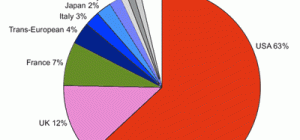 While it would be easy to debate the proper use of government allocated funds for various programs throughout the country, you would be hard pressed to find someone that would disagree that many aspects of our infrastructure require more attention than they currently receive. Whether we’re discussing pot-holed filled roads, bridges in poor repair or the water mains that deliver water to households and businesses alike, much of our infrastructure is aging and failing faster than work crews can fix them.
While it would be easy to debate the proper use of government allocated funds for various programs throughout the country, you would be hard pressed to find someone that would disagree that many aspects of our infrastructure require more attention than they currently receive. Whether we’re discussing pot-holed filled roads, bridges in poor repair or the water mains that deliver water to households and businesses alike, much of our infrastructure is aging and failing faster than work crews can fix them.
Many of the water mains in the United States for example are pressing sixty years old, having been installed in the early 1960’s. While pipeline condition assessments typically relied on visual inspections in the past, new technologies are emerging that are helping municipalities pinpoint areas where work crews can focus their attentions and conduct repairs prior to water mains failing completely. By having reliable water main monitoring systems in place, municipalities are able to prioritize their repair schedules and budgets accordingly. This results in better use of funds with the added bonus of being able to plan repairs and ensure that the highest priority areas that could lead to costly and time consuming leaks happen less frequently.
New Water Main Leak Detection Technology
Technology as a whole in many industries has significantly advanced in the last decade, and although the water pipes that deliver our water are not often spoken of, new detection technologies have emerged for them as well. There are now several companies that have created devices that allow municipalities to measure the thickness of the pipe walls for a long span of underground piping, without the need to visually inspect the pipes themselves.
Some of these new technologies to emerge are pipeline condition assessment methods—both robotic and acoustic-based—that allow for “dig free condition assessment”. There are several advantages to each type of technology.
Robotics: for instance as capable of performing short and long-range inspections under various operating conditions under both dry pipes or while submerged. They also can reach distances of up to 2.9 kilometers and can travel up to 85 feet per minute during time sensitive analysis is needed. There is also no need for manned entry into the pipes themselves, and the robots can have their track feet changed depending on the diameter of the pipe. Additionally, robotics can provide immediate data results while performing detailed analysis of the structural integrity of the pipes.
Sonar: Meanwhile, acoustic-based pipeline condition assessment devices use a new type of sonar that actually flex the pipe walls on the microscopic level. Thicker pipe walls are more resilient to this flexing and the instruments are able to measure the thickness of the pipes as a result. Using complex algorithms to determine the sound waves are canceling each other out in the section of pipes analysed, municipalities can then determine where leaks are occurring, or better yet, where they’re likely to occur next!
Roads and Buildings Are Just As Important
Despite renewed focus to maintain vital infrastructure, there are still reasons why roads and buildings, just like their underground pipe counterparts, are deteriorating faster than municipalities can keep up with them:
- Reduced funding.
- Population growth.
- Higher health and environmental requirements and standards.
- Quality control issues leading to improper installations.
- Lack of consistency and uniformity in design and maintenance.
As a result, many municipalities have begun searching for alternative ways to reduce maintenance costs by using emerging technologies as mentioned with regards to water mains. This new technology however is not limited to pipes – there have also been several advancements in concrete as well that are clean, cheaper, and better ways to help keep our roads and buildings in good repair.
Believe it or not, there are now ways that bacteria can be used to fill cracks when they’re protected in silica gel. These bacteria can be applied to concrete to help mitigate and heal cracks that occur. While concrete itself is a great building material and it’s easy to make and relatively cheap to produce and use, it can crack over time. Applying this special bacteria and silica gel solution to the concrete will help it last longer as well as heal itself when it does crack.
Technology is rapidly changing and we continue to find innovative ways to help use, create better, longer lasting products in all aspects of our lives, including our vital infrastructure systems. Governments are learning to become better at spending their increasingly limited funds to ensure the maintenance these systems need to remain safe and functional.







